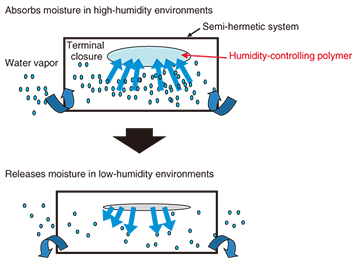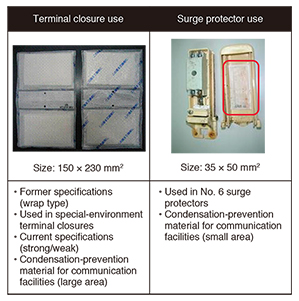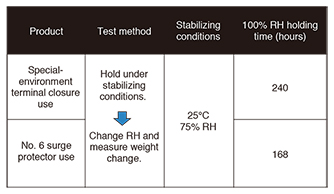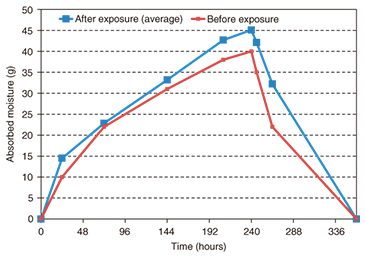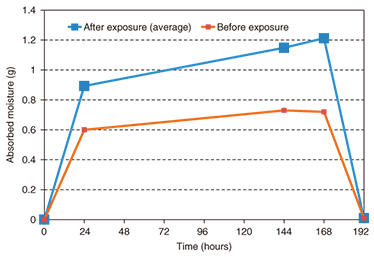 |
|
|
|
|
|
Practical Field Information about Telecommunication Technologies Vol. 14, No. 4, pp. 65–69, Apr. 2016. https://doi.org/10.53829/ntr201604pf1 Long-term Durability of Humidity-controlling PolymerAbstractThis article describes an evaluation of humidity-controlling polymer that was tested for use in telecommunication facilities. This is the thirty-fourth article in a bimonthly series on telecommunication technologies. This month’s contribution is from the Materials Engineering Group, Technical Assistance and Support Center, Maintenance and Service Operations Department, Network Business Headquarters, NTT EAST. Keywords: humidity control, CCP cable, insulation failure 1. IntroductionInsulation failure in core wires of color coded polyethylene (CCP) cable within terminal closures and surge protectors can occur when there is contact between wires or condensation of moisture on cracks in the wire covering. Solving the former problem requires maintaining an appropriate distance between wires or using additional insulation, while solving the latter problem requires removing the moisture. Humidity-controlling polymer is a product that can prevent water condensation. It can absorb moisture (humidity) in the installation space and release moisture during dry periods so as to maintain a fixed level of humidity. Installing this product can reduce the probability of insulation failures occurring in metal wires. However, because CCP cable must have long-term and stable use to provide customers with uninterrupted service, humidity-controlling polymer must likewise maintain long-term performance. 2. Reduction of insulation failures in metal wires by installing humidity-controlling polymerCondensation often occurs in No. 6 surge protectors in regions with high rainfall or where dense fog occurs frequently, so insulation failures accompanying cracks in the wire covering can easily occur in such situations. When humidity-controlling polymer was installed for experimental purposes inside No. 6 surge protectors in regions with relatively frequent occurrences of insulation failures, it was found that the number of failures that occurred dropped to as low as one-tenth that before installation. Although insulation failures cannot be completely eliminated by installing humidity-controlling polymer, it can greatly reduce the frequency of their occurrence. In this capacity, it is a useful product for reducing maintenance operations and maintaining the quality of communication services. 3. Humidity-controlling polymer evaluated for long-term durabilityHumidity-controlling polymer has properties enabling it to absorb ambient moisture (water vapor) in high-humidity environments and to release moisture in low-humidity environments in order to maintain a fixed level of humidity in an installation space (Fig. 1). It uses a sodium-polyacrylate super absorbent polymer (SAP), a material also used in disposable diapers. Several types of humidity-controlling polymer have come into use since the initial introduction of SAP. We evaluated two such products for long-term durability, as summarized in Table 1. These consisted of humidity-controlling polymer for use in special-environment terminal closures and humidity-controlling polymer for use in surge protectors. These two products were installed in terminal closures and No. 6 surge protectors (with and without sealing the feed-through apertures) for about 9 years and 7.5 years, respectively, and then recovered for evaluation (Photo 1). The equipment the products were used in was installed in an area with a relatively high occurrence of strong winds caused, for example, by typhoons.
4. Humidity absorption/release performance testAs described above, humidity-controlling polymer absorbs ambient moisture in high-humidity environments, as on rainy or foggy days, and releases the absorbed moisture in low-humidity environments, as on sunny days, in order to maintain a fixed level of humidity in the installation environment. We therefore decided to test this absorption/release function in the product that had been targeted for evaluation of long-term durability. In particular, we wanted to assess whether the product’s performance was equal to or better than the performance at the time of its manufacture. During the test, the relative humidity (RH) was changed using the three-step procedure described below, and the weight of the product was measured at each step to evaluate the amount of moisture absorption (Table 2).
Step 1: The humidity-controlling polymer was held under fixed temperature/humidity conditions in a state of little weight change over time (stabilizing conditions: temperature = 25°C, RH = 75%). Step 2: The RH was increased to 100% and held there for a fixed time (holding time: 240 h for special-environment terminal closure, 168 h for No. 6 surge protector). Step 3: On completion of the 100% RH holding time, the product was held under the same stabilizing conditions as in step 1. The test results showed that the moisture absorption/release performance of both the humidity-controlling polymer for special-environment terminal closures and that for No. 6 surge protectors after long-term installation was equivalent to that at the time of manufacture. Results of this moisture absorb/release test are shown in Figs. 2 and 3.
On the basis of these results, we can say that the humidity-controlling polymer continues to exhibit the same function as that when first installed even after long-term use, and that it has a long-term effect in countering insulation failures in metal wires caused by condensation of moisture on cracks in wire covering. 5. ConclusionIt has been more than ten years since humidity-controlling polymer was first introduced. This article provided information as to whether they are still effective in preventing insulation failures by testing products actually installed—not those used in special test environments. It is our sincere hope that this information will prove useful to those in charge of maintenance operations in the field. Going forward, the Technical Assistance and Support Center is committed to performing more tests and surveys to uncover information that can be of great use in field operations. |
|









